Townshend, Barbara Anne (McKechnie Section 1)
Recorded by Jackson (The History of Silhouettes). The earliest information we have of Miss Townshend’s existence is provided by the scrapbook which she gave her god-daughter, Harriet Brooke, on 4 November 1805, and which contains silhouettes cut almost certainly by Harriet (q.v. for details of this book).
Miss Townshend’s undoubted independent work is known from a book containing aquatint engravings by M. Dubourg after silhouettes cut by her, first published in 1808 by Edward Orme (see Appendix Two); further known editions followed in 1815 and 1836 (the third being published by Adolphus Richter and Company, 30 Soho Square, London).
600
The first edition was sold at 5s.; alternatively each page could be bought singly, at 1s. each. Each page bears the inscription, ‘Published by Ed. Orme, Jan 1st. 1808’. The book is printed on white paper. A copy of the 1815 edition (which is entitled The Art of Cutting out Designs in Black Paper) was formerly in Jackson’s collection. It was in paper covers, and single sheets were originally offered for sale at 1s each. The author’s introduction begins ‘In the Art of Cutting Out, it is difficult to render assistance to the young artist by instruction, but a few rules may afford improvement by being observed. When a group of figures are to be cut , after designing a subject in the mind, cut the general outline in a rough manner, and correct and finish them afterwards: flowers, on the contrary, must be carefully and exactly cut out first, and open parts to be done after the leaves and blossoms are formed…’ After giving advice on freehand cutting and the drawing of designs, Miss Townshend continues, ‘In this work, every style of cutting is introduced that may be useful to those who wish to learn the art.’ Another copy of this edition, containing over a hundred pages, has come to light (it is owned by Mr E. H. Denman).
It is possible that further editions appeared before the 1836 edition (a copy of which is in the D. S. Patton collection). This edition has a new title (Sibyl-leaves) and a new introduction:
In the Art which it is the object of this publication to introduce to the juvenile pupil it is difficult to convey the instruction that may be rendered immediately available. A few short rules, however, may afford information sufficient to encourage the young artist to proceed with unrelaxed zeal in the acquirement of this entertaining and instructive amusement.
The paper best calculated for the purpose is thin black paper, either dyed black or glazed, according to taste; the scissors to have long shanks, with short and sharp points.
It is more advisable to cut on the white side of the paper, in order to distinguish clearer.
When a group of figures is selected and the subject designed in the mind, the general outline should be cut in a rough manner, and afterwards corrected and finished; flowers on the contrary, must be carefully, and exactly cut at [sic] first, the fibres and open parts to be completed after the leaves and blossoms are formed.
It is necessary to commence at the feet, and gradually proceed along the back of the figure: particular attention must be paid in having the arms introduced both together and properly used, as mistakes frequently arise from clipping on the white side of the black paper, which gives both irregularity and awkwardness to the figure.
Let the lines flow as in drawing, according to the line of beauty; straight and acute lines give a formality.
Flowers should be cut elegantly and accurately; all twining plants are best adapted for the scissors.
Neatness and exactness must be particularly observed in cutting vases, tablestands, &c.
By drawing the designs first it takes greatly from the merit of cutting; therefore, it is advisable for the learner, not to begin with doing so, but to form the figures with the scissors, without the aid of the pencil: a figure which looks well in drawing has a contrary effect in cutting; for in paper there must be more left to the imagination, and it being impossible to describe foreshortening with the scissors, as with the pencil, the figures, therefore, must be selected with judgment, so as to display the whole form.
The title is a little obscure; perhaps Miss Townshend was referring to the allegorical nature of many of the cuttings. The pages of this edition, measuring 15 x 9¾ in., are smaller than those of the copy of the 1815 edition formerly in Jackson’s collection. There are thirty-one illustrations; the first edition may have contained a few more, which were later destroyed. The first fourteen illustrations are printed two to a page and there are no inscriptions under them. At least one of these illustrations had been printed in the 1808 edition, for it is identical with the example from that edition which I have illustrated.
600
In fact, all these fourteen illustrations may have been reprinted from the 1808, 1815 or now unknown later editions. Each of the pages containing the last fifteen illustrations bears the following inscriptions at the foot: ‘Miss B. Anne Townshend del.’ (on the left) and ‘M. Dubourg sculpt.’ (on the right). Some of these pages are illustrated in this Section. This edition is printed on sheets o f different colours, including green, lavender, cream, salmon-pink and apricot.
The illustrations which I have chosen show that Miss Townshend was an extremely able cutter, talented and inventive.
I quote below a list of the captions to the illustrations in the copy of the 1815 edition of Miss Townshend’s book formerly owned by Jackson:
1 Two ladies with children in a garden
2 Six dancing figures round a maypole
3 A spray of passion flower with butterflies
4 Six cooks and scullions at work in a kitchen
5 Six figures male and female in fancy dress
6 Four studies of birds, parrots, pheasant, etc.
7 Three vases of pseudo-Greek design
8 Six witches in consultation, broomsticks, cats etc.
9 Six female figures in pseudo-Greek dress
10 Dancing figures in Greek dress with cupids
11 Ivy spray, vetch, and butterflies
12 Ladies in Greek dress with children and dogs
13 Four men in eighteenth-century dress, two women dancing
14 Three vases, pseudo-Greek design
15 Vintage, five figures, goat, etc.
16 Scotsman in Tartan, boy with harp approaching a ruin
17 Six women and children
18 Birds and nest, ruined arches
19 Ivy spray, butterflies
20 A peep show, three adult and three children’s figures
Ills. 600-613
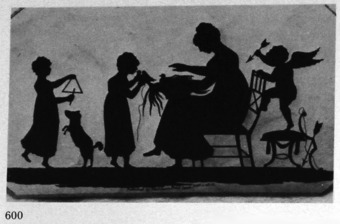
M. Dubourg, after Barbara Anne Townshend
Print, engraved after a cut silhouette by Miss Townshend
Date of publication of print: 1 January 1808
Inscribed: ‘Published by Edwd Orme, Bond Street, Jan. 1st 1808’.
Although this print does not bear the names either of Dubourg or of Miss Townshend, it was printed (so inscribed) in a later edition of Miss Townshend’s works, and its provenance can therefore be considered established. (For Orme, see Appendix Two.)
Author’s collection
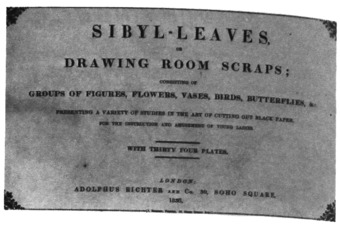
Barbara Anne Townshend Sibyl-leaves (London, 1836). Title page.
D. S. Patton collection

Barbara Anne Townshend Sibyl-leaves (London, 1836). The inscription (the same as those in the edition of 1815) printed at the foot of each page (left and right respectively).
D. S. Patton collection

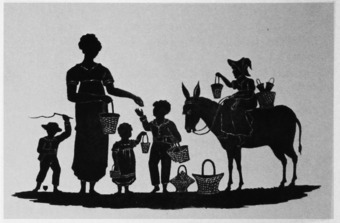
Sheet No. 7
7½ x 9¾in./191 x 248mm.
Printed on white paper.
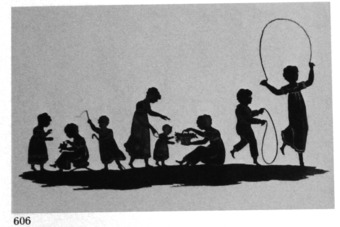
Sheet No. 13
7½ x 9¾in./191 x 248mm.
Printed on apricot paper.
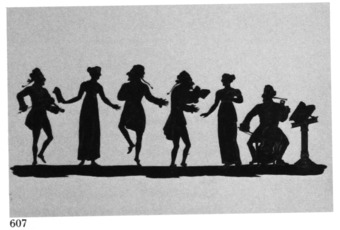
Sheet No. 17
9¾ x 15in./248 x 382mm.
Printed on cream paper.
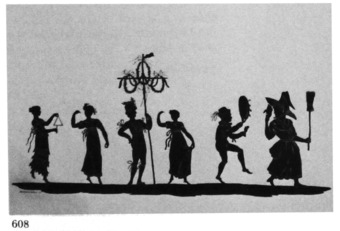
Sheet No. 18
9¾ x 15in./248 x 382mm.
Printed on pale yellow paper.
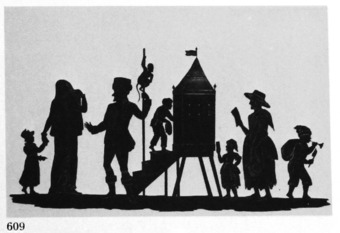
Sheet No. 20
9¾ x 15in./248 x 382mm.
Printed on pale yellow paper.
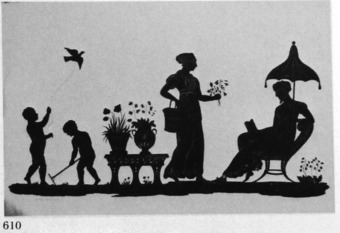
Sheet No. 21
9¾ x 15in./248 x 382mm.
Printed on pale orange paper.
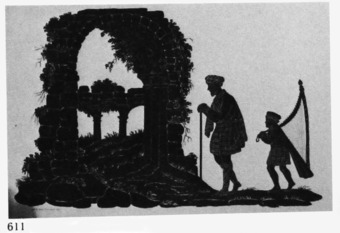
Sheet No. 24
9¾ x 15in./248 x 382mm.
Printed on blue paper.
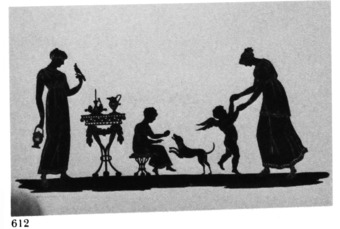
Sheet No. 25
9¾ x 15in./248 x 382mm.
Printed on pink paper.
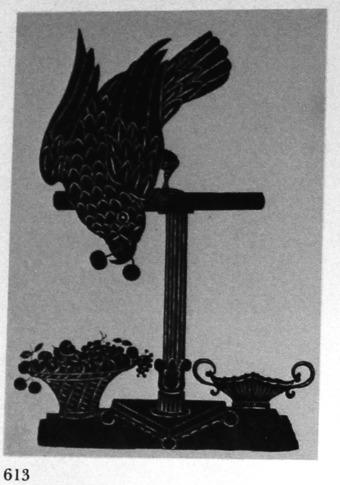
Detail from Sheet No. 29
Size of whole sheet: 9¾ x 15in./248 x 382mm.
Printed on cream paper.
